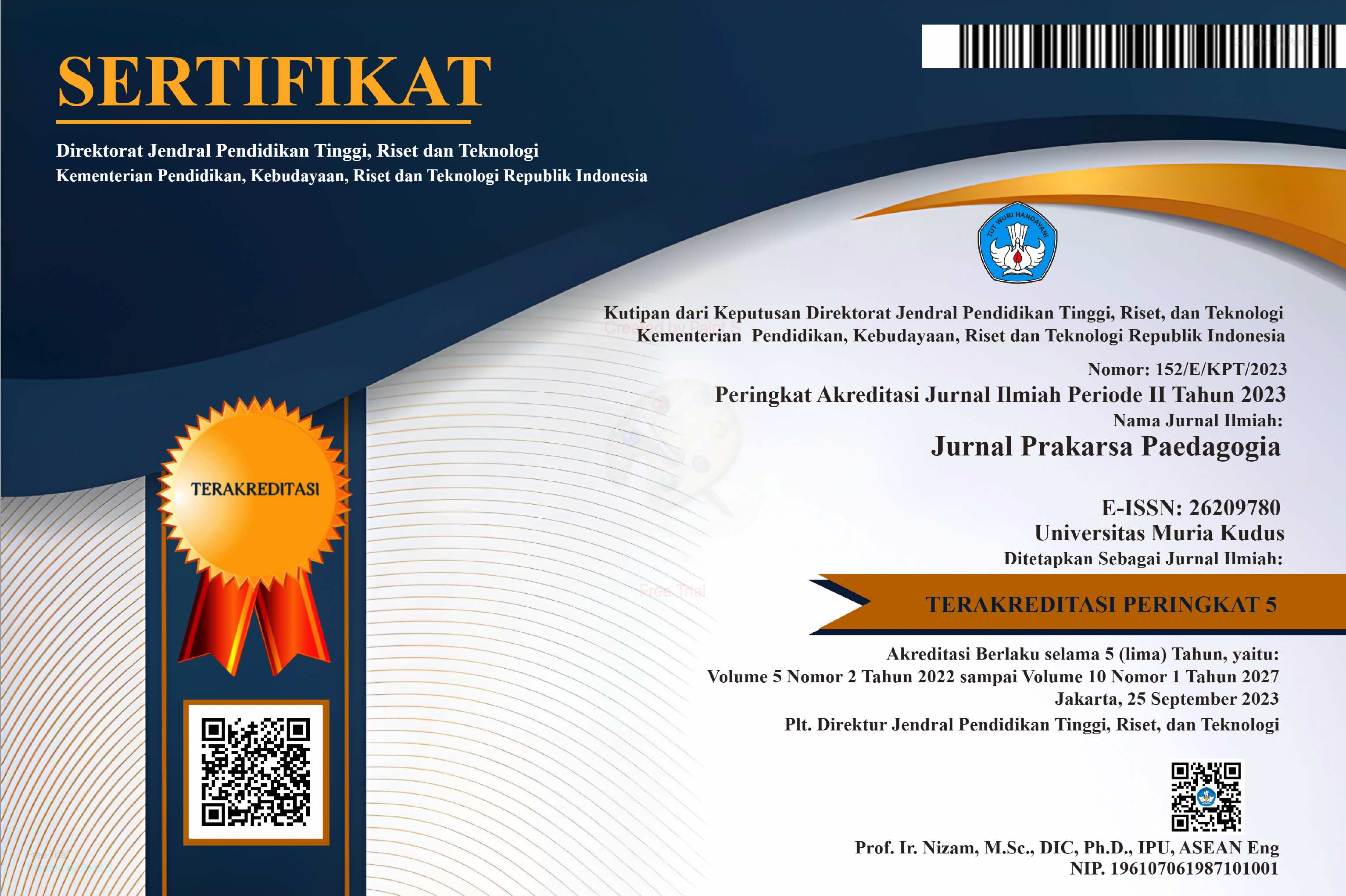Perilaku Bullying pada Anak Usia Sekolah Dasar di Desa Gribig, Kudus
Abstract
Keywords
Full Text:
166-174 (Bahasa Indonesia)References
Amalia, Febriyani Yasinta. Sri, Indarwati Endang. 2016. Konformitas Teman Sebaya dan Perilaku Bullying pada Siswa Kelas XI IPS. Jurnal Empati. Vol. 5, No. 1. Hal 138-143
Amnda, Viola. Wulandari, Septia. Wulandari, Suci. Nabila, Syah Saskia. Andi, Restari Yopie. Atikah, Septina. Engkizar. Anwar, Fuady. Arifin, Zainul. 2020. Bentuk dan Dampak Perilaku Bullying terhadap Peserta Didik. Jurnal Kepemimpinan dan Kepengurusan Sekolah. Vol. 5, No. 1. Hal 19-32
Angelis, B. 2003. Percaya Diri: Sumber Sukses dan Kemandirian. Jakarta: PT Gramedia Pustama Utama.
De Vega, Asla. Hapidin. Karnadi. 2019. Pengaruh Pola Asuh dan Kekerasan Verbal terhadap Kepercayaan Diri. Jurnal Obsesi. Vol. 3, No. 2. Hal 433-439
Dewi, Ani Sri. Nurhayati, Tati. 2019. Pengaruh Bullying Verbal di Lingkungan Sekolah terhadap Perkembangan Perilaku Siswa. Jurnal Edueksos. Vol. 8. No. 2. Hal 88-101
Fatimah. 2010. Psikologi Perkembangan: Perkembangan Peserta Didik. Bandung: Pustaka setia.
Fatimatuzzahro, Adinar. Nimah, Suseno Miftahun. Irwanto. 2017. Efektifitas Terapi Empati untuk Menurunkan Perilaku Bullying pada Anak Usia Sekolah Dasar. Jurnal: Petik. Vol. 3, No. 2. Hal 1-12
Febriyanti, Korua Sally. Kanine, Esrom. Bidjuni, Hendro. 2015. Hubungan Pola Asuh Orang Tua dengan Perilaku Bullying pada Remaja SMK Negeri 1 Manado. E-Journal Keperawatan. Vol 3. No. 2. Hal 1-7
Ghufron, N. d. 2011. Teori-teori Psikologi.Jogjakarta: Ar-Ruzz Media.
Iswidharmanjaya, Enterprice. 2014. Pengembangan Sikap Anak Usia Dini. Bandung: CV Alfabeta.
Lauster, P. 2002. Tes Kepribadian. Jakarta: Bumi Aksara.
Lombonaung, Junitha. Patalatu, Stenlly. Petrus, Jerizal. Pengaruh Bullying terhadap Kepercayaan Diri Siswa di SD Se-Kacamatan Tobeloo Tengah Kabupaten Halmahera Utara. Cakrawala Jurnal Pendidikan. Vol. 14. No. 1. Hal 80-88
Miles, M.B. & Huberman, A.M. (1992). Analisis data kualitatif (diterjemahkan oleh Tjetjep Rohendi Rohidi). Jakarta. UI Press.
Moleong, Lexy. 2010. Metode Penelitian Kualitatif. Jakarta: UI Press.
Nanda, Putri Hertika. Annis, Nauli Fathra. Novayelinda, Riri. 2015. Faktor-Faktor yang berhubungan dengan Perilaku Bullying pada Remaja. JOM. Vol. 2. No. 2. Hal 1149-1159
Olweus.1993. Bullying At School: What We Know And What We Can Do. Oxford: Blackwell.
Selvia, Futri. Yuwono, Puji Sugiharto. Samsudi. 2017. Jurnal Bimbingan Konseling. Vol. 6. No. 1. Hal 20-27
Simbolon, Mangadar. Perilaku Bullying pada Mahasiswa Berasrama. Jurnal: Psikologi. Vol. 39. No. 2. Hal 233-243
Sugiyono. 2016. Metode Penelitian Pendidikan Pendekatan Kuantitatif, Kualitatif, dan R & D. Bandung: Alfabeta.
Taylor, R. 2011. Kiat-Kiat Pede Untuk Meningkatkan Rasa Percaya Diri. Jakarta: PT Gramedia Pustaka Utama.
Ulum, Ahmad Syaikhul. Sumarwiyah. Pertiwi, Ika Ari. 2019. Peningkatan Sikap Percaya Diri Siswa melalui Model Teams Games Tournament Berbantuan Media KArtu Kelas IV SD 2 Bakalan Krapyak. Jurnal Prakarsa Pedagogia: Vol. 2 No. 1. Hal 107-115.
Yayasan Semai Jiwa Insani. 2008. Bullying: Mengatasi Kekerasan di Sekolah dan Lingkungan. Jakarta: Grasindo.
Yulia, Angga Dewi Putu. 2020. Perilaku School Bullying pada Siswa Sekolah Dasar. Jurnal Edukasi: Pendidikan Dasar. Vol. 1, No. 1. Hal 39-48
DOI: https://doi.org/10.24176/jpp.v4i2.5989
Refbacks
- There are currently no refbacks.
Copyright (c) 2022 Jurnal Prakarsa Paedagogia

This work is licensed under a Creative Commons Attribution-NonCommercial-ShareAlike 4.0 International License.
Visitors of the Paedagogia Prakarsa Journal Status
Country of Origin of Visitors:
Jurnal Prakarsa Paedagogia dari Fakultas Keguruan dan Ilmu Pendidikan Universitas Muria Kudus is licensed under a Creative Commons Attribution 4.0 International License.
Dedicated to:







